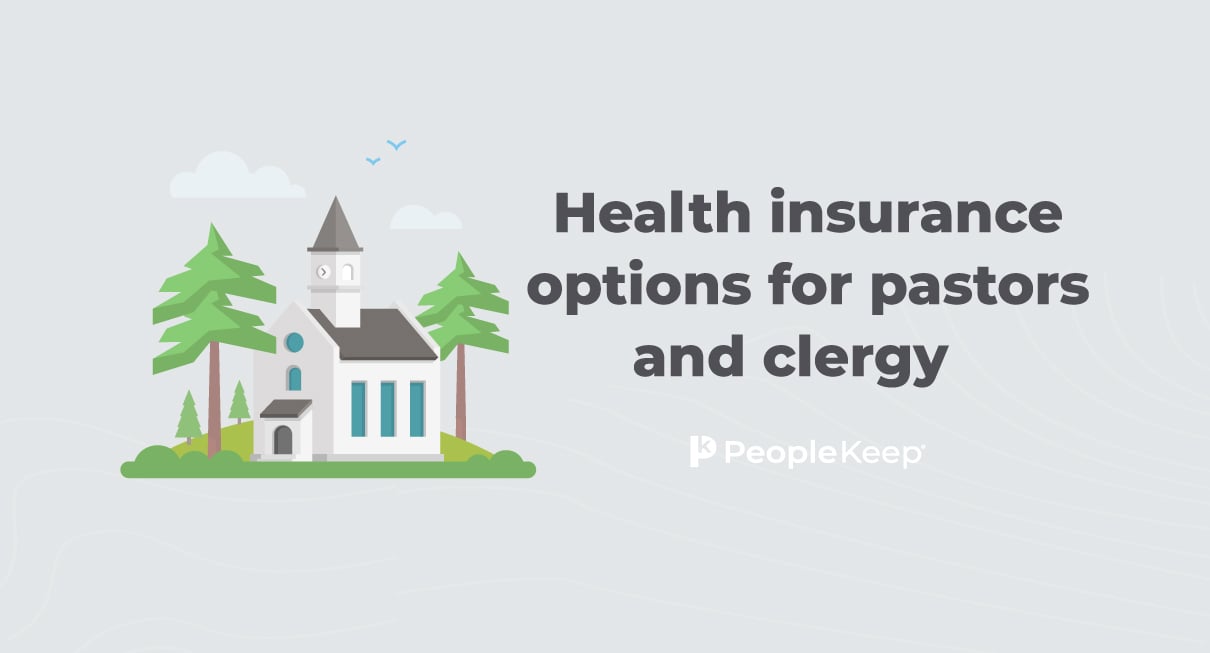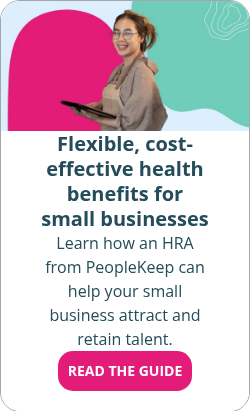Small business health insurance costs: What can you expect?
By Holly Bengfort on July 28, 2025 at 8:00 AM
The cost of traditional group health insurance continues to rise, causing some employers to wonder if offering health benefits will soon become unsustainable. This is especially true for small businesses with tight budgets, limited resources, and fewer employees to help meet the group health plan’s participation requirements.
So, what's a small business owner to do when offering health insurance seems unrealistic given budget constraints? Below, we'll discuss the costs small organizations can expect when offering employer-sponsored health insurance. We’ll also explain how businesses can control costs and support their employees with a health reimbursement arrangement (HRA).
In this blog post, you’ll learn:
- How much group health insurance costs small businesses when considering premiums and the time spent on administration, compliance, and renewals.
- Why HRAs are a flexible and cost-effective alternative to group health insurance coverage for small businesses.
- How small organizations can maintain competitive benefits while avoiding participation requirements and high healthcare costs.
How much do group health insurance premiums cost?
According to KFF, group health insurance premiums in 2024 averaged $8,951 a year for single coverage — roughly $746 monthly — and $25,572 for family coverage, or about $2,131 monthly. The average annual premium for single and family plans increased by 7% over the last year1.
Here are a few factors that can impact premium costs for small businesses:
- Plan type: Monthly premiums tend to run higher depending on the type of coverage. For example, preferred provider organization (PPO) plans typically have higher premiums than health maintenance organization (HMO) policies.
- If you’re offering a SHOP plan from the ACA exchanges, premiums also vary by metal tier type. For instance, platinum plans have higher rates than bronze plans.
- Location: The average cost for single and family coverage is higher in the Northeast and Midwest regions of the United States. This may be due to higher living costs, more health insurance requirements, and less competition among insurance carriers in these areas.
- Industry: Premium prices are often higher for industries with greater health and injury risks, such as transportation, construction, and utilities.
- Employee age: Premiums will typically be lower for employees younger than 21 because insurance carriers don’t expect younger individuals to need as much healthcare. If you employ many older workers, your entire group’s premiums may rise.
Implementing higher cost-sharing requirements for employees can reduce your health benefits budget. However, adding cost-sharing increases the risk that eligible employees won’t participate in the plan.
Health insurance companies typically require at least 70% of employees to enroll in a group health plan. If too many employees choose not to participate in the coverage, you may not be able to offer the policy at all.
How much time does it take to administer a group health insurance plan?
While many organizations are aware of the cost of health insurance, they're less prepared for another factor: the time needed to administer the plan. For most small business owners trying to get as much done with as little staff as possible, the time spent on administration might even exceed the high premium costs.
Below, we’ll review three factors that make managing a group health insurance plan time and labor-intensive:
- Tracking ongoing regulatory changes
- Navigating complex communication procedures
- Completing annual renewal processes
1. Tracking ongoing regulatory changes
Many small businesses don't have the option of hiring an entire human resources team to handle the administrative tasks of offering group health insurance coverage.
In many cases, an already busy employee must become the go-to person for:
- Educating staff on health insurance coverage options
- Explaining which employees are eligible for health insurance
- Outlining which local facilities are in- or out-of-network providers
- Describing the covered services under the group health insurance plan
- Notifying employees of plan changes
- Answering questions or concerns
Without someone handling these tasks full-time, it's easy for some rules to slip through the cracks, which could put your plan out of compliance. Noncompliance with the Affordable Care Act (ACA) and the Employee Retirement Income Security Act of 1974 (ERISA) comes with hefty penalties of up to thousands of dollars.
2. Navigating complex communication procedures
Group health insurance plans require businesses to undergo complicated communication procedures between employers, the health carrier, and their employees.
The complexity of these plans often forces employers to become an intermediary between the health insurance company and employees. For example, they may need to manage tedious and unorganized back-and-forth communication via phone and email updates every time an insurance issue surfaces.
Typically, larger companies can easily take on these tasks because they have greater resources or a dedicated HR team. But for many small business owners, this time and energy is better spent running their businesses.
3. Completing annual renewal processes
Like other employee benefits, the annual renewal process for group health insurance plans can be complicated and take a lot of time to complete. For example, suppose your employees filed more health insurance claims than the previous year. In that case, you’ll likely experience premium increases or changes in plan terms during renewal time.
You must consider whether you will accept the changes, negotiate with the carrier, or work to identify new health insurance options that better match your budget and goals. This process may take time, and you may need to meet with new insurance brokers.
If small organizations spend just four hours each month of one employee's time managing benefits day-to-day and five days during benefits renewal, that's an additional 88 hours of the employee's time that could have gone to other tasks.
Group health insurance options are limited for small organizations
The annual health insurance costs and minimum participation requirements for group plans leave many small employers with just one or two policies to choose from. This means many employees don't get the policy they want. Available insurance options may not cover their healthcare needs, or they might be unable to afford the policy entirely.
Employees in this situation may choose not to participate in the policy. This could mean your organization won’t meet the policy's minimum participation requirements, forcing you not to offer a benefit. However, a 2024 PeopleKeep Survey found that 92% of employees say having a health insurance benefit is essential to them. So, offering a health benefit is key to keeping employee turnover low.
Turnover can be a significant cost, especially for small businesses. Recent data found that replacing an employee these days can cost between half and four times their annual salary, depending on the role and level of experience2.
Therefore, crafting a compensation package with an attractive health insurance benefit is worth your time and money. Otherwise, you may have to invest those resources into replacing employees who leave your company for other businesses that offer health insurance coverage.
How small organizations can control their health benefits costs with an HRA
Unsurprisingly, small businesses may decide they can't afford traditional group health insurance's financial and administrative costs. But going without health insurance benefits isn't the answer, as the decline in morale and retention is even higher.
Many small organizations find that stand-alone HRAs are one of the most effective ways to offer a quality health benefit on a tight budget. With a tax-advantaged HRA, you provide employees with a set monthly allowance instead of paying group plan premiums. Then, your participating staff members buy individual health insurance and other qualifying out-of-pocket costs.
Here are a few examples of HRA-eligible expenses:
- Doctor visits
- Preventive care
- Prescription drugs
- Over-the-counter medicine
- Physical and mental health support
- Copayments
- Emergency services
- Hospitalization
- Laboratory services
Once your employees submit claim documentation proving they paid for a medical service or item, you reimburse them tax-free up to their allowance amount. Once they reach their monthly allowance threshold, they can’t exceed it.
HRAs don’t require you to pre-fund them, unlike health savings accounts (HSAs). You only pay employees after you approve an eligible expense, and unused HRA allowance funds stay with you if they leave your company. You also don’t pay payroll taxes on HRA reimbursements, and employees are exempt from income taxes on the amounts.
In the sections below, we’ll review two HRAs that can support small businesses.
Qualified small employer HRA (QSHERA)
A qualified small employer HRA (QSEHRA) is an excellent choice for small businesses, as it’s only for employers with fewer than 50 full-time equivalent employees (FTEs). As long as employees have minimum essential coverage (MEC), such as an individual health plan from the ACA Marketplace or a spouse’s group policy, they can receive tax-free reimbursements for their out-of-pocket medical costs. Only those with individual plans can get tax-free reimbursements for their premiums.
Unlike other HRAs, the IRS sets annual maximum contribution limits for the QSEHRA. However, small businesses assume less financial risk since there are no minimum employer contribution limits. But the flexibility doesn't end there.
QSEHRAs don't have participation requirements. So, even if you only have one or two W-2 employees, you can still have a QSEHRA. Your W-2 part-time workers can use the QSEHRA benefit as well. But they must receive the same allowance amount as your full-time employees.
Lastly, small employers can design their QSEHRA only to reimburse employees for their health insurance premiums if they want to save money. However, if you have the budget, you can allow reimbursements for premiums plus other out-of-pocket costs. This design gives your employees even greater financial help for medical care.
Individual coverage HRA (ICHRA)
Like the QSEHRA, an individual coverage HRA (ICHRA) allows employers to reimburse their employees, tax-free, for their individual health insurance premiums and other out-of-pocket expenses. While employers must have at least one W-2 employee to offer an ICHRA, it can support growing businesses as it has no maximum company size restrictions.
The ICHRA offers extensive flexibility for small businesses. It has no minimum or maximum employer contribution limits. If you’re new to the benefit, you can start with a smaller allowance and increase it over time with each plan renewal. You can also vary ICHRA allowances and eligibility requirements based on employee classes, age, and family status. This gives you greater control over your plan design and budget.
Lastly, if your business grows to the size of an applicable large employer (ALE), you don’t have to switch to a traditional group health insurance plan. You can use an ICHRA to meet the ACA’s employer mandate requirements if you design your benefit with an affordable allowance.
Conclusion
The cost of employer-sponsored health plans is incredibly steep for small business owners, not to mention the time required to administer the benefit. Given this, it's easy to see why HRAs are becoming a popular alternative. Luckily, HRAs help you offer flexible health insurance benefits while keeping costs in check and ensuring employees get necessary medical care.
With HRA administration software from PeopleKeep by Remodel Health, you can manage a QSEHRA or ICHRA in minutes per month. Whether customizing plan documents, reviewing reimbursement documentation, or navigating tax regulations and compliance, PeopleKeep guides small businesses through every step of managing their HRA benefit.
Ready to add an HRA to your benefits package? Schedule a call with an HRA specialist now!
This post was originally published on November 3, 2020. It was last updated on July 28, 2025.
Check out more resources
See these related articles

Health insurance options for pastors and clergy
Are you a minister or church looking for health insurance options? Explore our guide to find the best health insurance plans for pastors and clergy.

Health reimbursement arrangement (HRA) eligibility FAQs
Get answers to common questions about HRA eligibility. Learn who qualifies and how health reimbursement arrangements work for employers and employees.

Offering a QSEHRA vs. group health insurance
Compare QSEHRA with group health insurance. Learn the differences in cost, flexibility, and benefits to help you choose the best option for your business.



